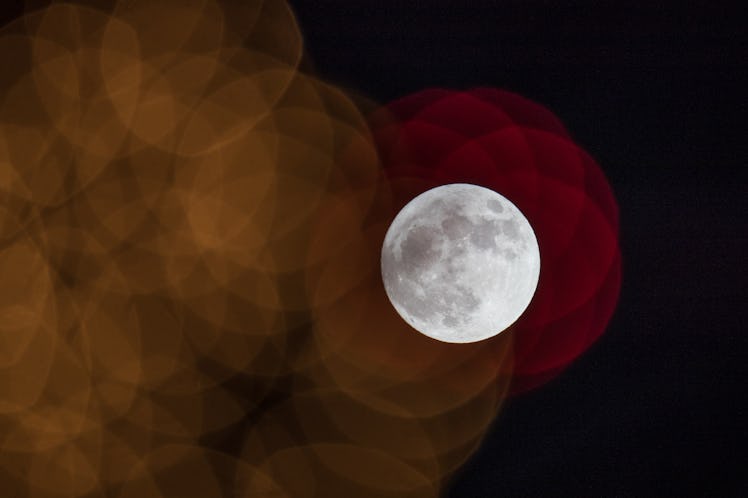
Photos Of The Super Blue Blood Moon & Lunar Eclipse Are So, So Breathtaking
There are a few "once in a lifetime" sights I'd like to see, and one of them is — without question — a super blue blood moon. Before appearing in the sky during the early hours of Jan. 31, the last super blue blood moon actually occurred 150 freaking years ago. But the photos of the 2018 super blue blood moon and lunar eclipse honestly look so unreal, and you should definitely check them out in case you missed the real thing.
Whether you caught the super blue blood moon on an iPhone or a Nikon DSLR, what really makes or breaks lunar photography is perfect timing. And during the super blue blood moon, timing was literally everything. New York City's ideal viewing time was around 6:45 a.m. ET, and on the West Coast, the it was at approximately 3:48 a.m. PT. Those in the Middle East, eastern Russia, Asia Australia, or New Zealand, however, were able to best view the phenomenon during moonrise, the morning of Jan. 31. In addition to perfect timing, though, NASA also recommended viewing the eclipse from a "high place," and for onlookers to direct their gaze north-northwest, away from sunrise. All of the photos captured are truly remarkable, and we're seriously applauding all of these talented AF photographers from around the world, for waking up so damn early.
All of these lunar photographs are so incredibly breathtaking, and I'm literally kicking myself because I missed out on it (TBH, I missed it because I was sleeping... I'm the worst, sorry guys). But if you're like me right now and you're having hella super blue blood moon FOMO, the pictures are really awesome, and hopefully technology will let us live for another, like, 150 years so we can see the next one.
Since, like most of us, you're probably super into astronomy, but you have no idea what any of it means, you're likely wondering what the moon was actually doing in its super blue blood moon state. To start, it was looking extra large and bright, because it was really close to Earth in its orbit. That's called a supermoon.
The moon was also simultaneously undergoing a total lunar eclipse. This is when the moon is blocked by sunlight, as it moves through the Earth's shadow. This is why it looked red, kind of like a sunset, or a basket ball... hence the term "blood moon."
Finally, occurring almost every three years, we had the second full moon in the same month, which is called a "blue moon." Yeah, we were all shocked it wasn't blue, too, but the moon will always be a mysterious goddess whom we'll never understand. So yeah, all of these wild moon happenings occurred on the same exact night, and that's why it's called a super blue blood moon. Makes sense, I guess. It's mad rare, so even though I didn't get to actually witness it, I'm pretty glad it graced us during my lifetime.
Unless you were catching z's during the phenomena that graces us only every 150 years (oops), the super blue blood moon might've gotten you thinking. Like, a lot. Several super blue blood moon on-lookers on Jan. 31 were feeling hella existential and poetic during the lunar phenomenon, because TBH, it was a truly thought-provoking sight to see. It feels simultaneously so scary and beautiful, to feel so small as part of such a large and amazing universe, and the tweets might actually convey exactly what you were thinking, too. We wouldn't be surprised, because it was honestly such a rare and beautiful sight. At this point, we're just really looking forward to see what the moon does next... and hopefully I'll be awake to see it.